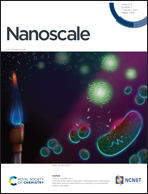Highly specific nuclear labeling via in situ formation of fluorescent copper nanoparticles†
Abstract
When imaging cells, nuclear counterstaining is imperative; however, many commercial nuclear-staining dyes based on nucleic acid intercalation result in nonspecific signals in the cytoplasm. Here, we propose a new strategy that stains the nucleus with high specificity by in situ formation of DNA-templated copper nanoparticles (CuNPs). We demonstrated that genomic DNA in the nucleus enabled rapid formation of highly fluorescent CuNPs immediately following addition of a copper ion source and ascorbate as a reducing agent. Moreover, we found that RNA and mitochondrial DNA, largely responsible for nonspecific cytoplasmic signals from commercial nuclear-staining dyes, did not mediate the formation of the highly fluorescent CuNPs, resulting in highly specific nuclear staining at a reduced cost relative to commercially available methods. Furthermore, we verified the compatibility of the proposed method with other fluorescence-labeling techniques. These results demonstrated the efficacy of this method and its promise as a powerful tool for cell imaging.



 Please wait while we load your content...
Please wait while we load your content...